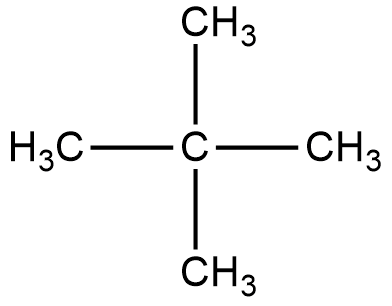
Answer
427.2k+ views
Hint:IUPAC has proposed certain rules for the nomenclature of organic compounds. Therefore, every organic compound is named according to these rules.
Complete step by step answer: Neopentane is the common name of the molecule. The structure of neopentane molecule is,

The steps for naming a simple organic molecule like this are,
Identify the longest carbon chain.
Count the number of carbons in that chain and name according to that. For one carbon it is methane, for two carbon it is ethane, for three carbon it is propane etc.
Identify side chains or functional groups if present.
Position of the side chain(s) or functional group(s) should be mentioned in the name. For that, numbering is done following the priority order. While numbering multiple side chains, the one with least sum should be taken.
If multiple side chains of the same atom or group are present, a number of side chains should be mentioned using the prefixes di-, tri-,tetra etc.
Let’s name the given compound, neopentane.
The longest carbon chain contains three carbon atoms. Hence the parental chain is propane. There are two methyl groups present on the same carbon. These methyl groups are present on the second carbon. Numbering in any direction gives the same number to the carbon containing methyl group. Since two methyl groups are present, a prefix di- should be used before the name of the side chain. Hence the name of the compound is,
And hence the correct option is B.
Note:
Even though IUPAC names are given to all compounds, some are always called by their common name.A chemical nomenclature is a set of rules to generate systematic names for chemical compounds. The nomenclature used most frequently worldwide is the one created and developed by the International Union of Pure and Applied Chemistry (IUPAC).
Complete step by step answer: Neopentane is the common name of the molecule. The structure of neopentane molecule is,

The steps for naming a simple organic molecule like this are,
Identify the longest carbon chain.
Count the number of carbons in that chain and name according to that. For one carbon it is methane, for two carbon it is ethane, for three carbon it is propane etc.
Identify side chains or functional groups if present.
Position of the side chain(s) or functional group(s) should be mentioned in the name. For that, numbering is done following the priority order. While numbering multiple side chains, the one with least sum should be taken.
If multiple side chains of the same atom or group are present, a number of side chains should be mentioned using the prefixes di-, tri-,tetra etc.
Let’s name the given compound, neopentane.
The longest carbon chain contains three carbon atoms. Hence the parental chain is propane. There are two methyl groups present on the same carbon. These methyl groups are present on the second carbon. Numbering in any direction gives the same number to the carbon containing methyl group. Since two methyl groups are present, a prefix di- should be used before the name of the side chain. Hence the name of the compound is,
And hence the correct option is B.
Note:
Even though IUPAC names are given to all compounds, some are always called by their common name.A chemical nomenclature is a set of rules to generate systematic names for chemical compounds. The nomenclature used most frequently worldwide is the one created and developed by the International Union of Pure and Applied Chemistry (IUPAC).
Recently Updated Pages
Who among the following was the religious guru of class 7 social science CBSE

what is the correct chronological order of the following class 10 social science CBSE

Which of the following was not the actual cause for class 10 social science CBSE

Which of the following statements is not correct A class 10 social science CBSE

Which of the following leaders was not present in the class 10 social science CBSE

Garampani Sanctuary is located at A Diphu Assam B Gangtok class 10 social science CBSE

Trending doubts
A rainbow has circular shape because A The earth is class 11 physics CBSE

Fill the blanks with the suitable prepositions 1 The class 9 english CBSE

Which are the Top 10 Largest Countries of the World?

How do you graph the function fx 4x class 9 maths CBSE

The Equation xxx + 2 is Satisfied when x is Equal to Class 10 Maths

What is BLO What is the full form of BLO class 8 social science CBSE

Change the following sentences into negative and interrogative class 10 english CBSE

Give 10 examples for herbs , shrubs , climbers , creepers

Difference between Prokaryotic cell and Eukaryotic class 11 biology CBSE




